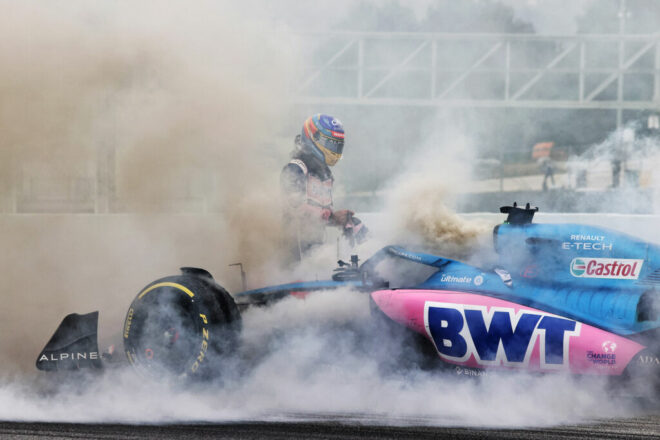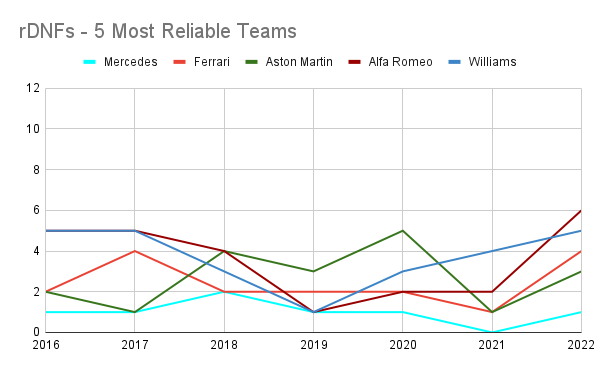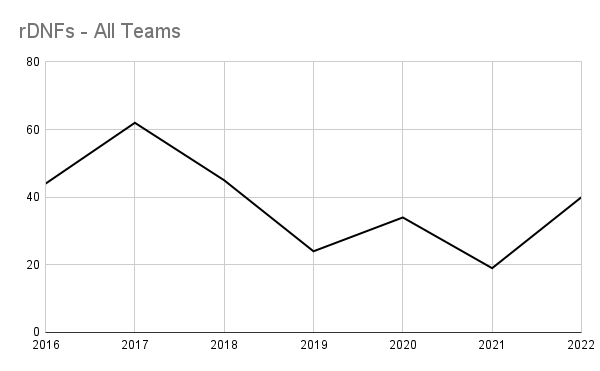-
 February 15, 2023, 12:33 pm
February 15, 2023, 12:33 pmLast Updated on February 22, 2023 7:43 pm by Stephen Michael | Published: February 15, 2023
There’s a well-known saying in Formula 1:
“In order to finish first, first you have to finish.”
And there are few more gut-wrenching moments on track for drivers, teams, and fans than seeing your car pull off onto an escape road with a mechanical failure.
Reliability is critical in F1 and DNFs due to reliability issues, or rDNFs, for our purposes, are fatal to a team’s hopes for a championship. In fact, in the last 7 years, the team that won the Constructors’ Championship has had the fewest number of rDNFs 5 times. Only Red Bull this past year (with 4) and Mercedes in 2018 (with only 2) have won the Constructors’ Championship without finishing with the fewest number of rDNFs on the year.
rDNFs are mechanical failures (of the power unit, gearbox, etc.) that do not allow a driver to participate in or complete a race. rDNFs do not include retirements due to crashes, offs, or problems with the tires, such as punctures or wheels coming off after pit stops. (Think Haas’ issues in Australia in 2018.)
A look at rDNFs over the last 7 years yields some interesting insights and even offers some hope for many teams. From 2016, when Haas joined F1, giving us the 10 teams currently on the grid, to 2022 there have been 144 races and 268 rDNFs, meaning there have been an average of 1.86 rDNFs per race. Almost 2 DNFs due to reliability issues leaves a lot of potential points on the table for teams, and has a significant impact on both the Drivers’ and Constructors’ Championships.
(Note: Teams listed below with their current names, but includes data from their previous iterations. Also, sprint races are not included in the table.)
Constructor 2022 (22) 2021 (22) 2020 (17) 2019 (21) 2018 (21) 2017 (20) 2016 (21) Total rDNFs Percent Mercedes 1 0 1 1 2 1 1 7 4.86% Ferrari 4 1 2 2 2 4 2 17 11.81% Aston Martin 3 1 5 3 4 1 2 19 13.19% Alfa Romeo 6 2 2 1 4 5 5 25 17.36% Williams 5 4 3 1 3 5 5 26 18.06% Haas 3 2 7 4 0 5 7 28 19.44% Red Bull 4 1 6 1 9 10 2 33 22.92% Alpha Tauri 5 4 2 2 8 8 6 35 24.31% McLaren 2 0 2 5 7 12 8 36 25.00% Alpine 7 4 4 4 6 11 6 42 29.17% Has Alpine really had an rDNF in almost 30% of its races over the last 7 years?
Yes! Alpine has had an rDNF in a staggering 29.17% of its races since the start of 2016. Not finishing nearly 30% of your races due to reliability over a 7-year period is one way to ensure you will not win a championship. They haven’t had fewer than 4 rDNFs in any season over that span, and have topped out with 11 in 2017. They have been the least reliable car on the road and have certainly suffered as a result. However, all hope is not lost for the Enstone-based team, as they have finished in the top-5 in the Constructors’ Championship in the past 5 years despite their woes. If they can improve their reliability, a case can be made that they can break into the top-3 and even compete for a championship. The other four teams rounding out the bottom five are McLaren, who had the most rDNFs in any one year when they had 12 in 2017, Alpha Tauri, who has seen a marked improvement over the last five years, Red Bull, who has also improved dramatically of late, and Haas, who has been both up and down over the years. All have averaged rDNFs in about 20% of their races from 2016-2022.

Who has been the most reliable team over the last 7 years?
It will probably come as no surprise that Mercedes was the most reliable team on the grid from 2016-2022. Having an rDNF in fewer than 5% of its races has no doubt contributed to the 6 Constructors Championships and 5 Drivers’ Championships in that span. The Merc is so reliable that it has only had more than 1 rDNF in 1 year since the start of 2016. (That came in 2018 when the team had 2 rDNFs and won both championships.) The reliability of the Mercedes certainly kept it in the fight in 2022 and is one of the main pillars of one of the best teams in F1 year-in and year-out. For perspective, Merc has had fewer rDNFs in 7 years (7) than Alpine had just last year (8.) The other four teams topping the charts for reliability are Ferrari, Aston Martin, who has been the third most reliable team on the grid, Alfa Romeo, who saw an uptick in reliability issues this past year, and Williams, who has been consistently near the middle of the pack.

So is Ferrari not as unreliable as everyone thinks?
No, it would appear that for all the hand-wringing about Ferrari, they have actually been one of the most reliable teams on the grid in recent years. Ferrari has had an rDNF in only 11.81% of races over the last 7 years, and has not had more than 4 rDNFs in any one year in that span. It has certainly not been as reliable as Mercedes, but at second on the road it is hard to make the case that reliability has prevented Ferrari from capturing a championship in recent times. This might be cold comfort for the Tifosi, but if Ferrari can clean up their problems with strategy and reduce the number of driver errors on track, it has the reliability to win multiple championships over the next few years.
But can reliability be improved upon year over year?
Yes, it certainly can. Red Bull is a prime example of how a team can address its reliability issues and start winning championships. Red Bull was one of the least reliable cars on the road in 2017 and 2018, leading the grid in rDNFs in those two years with 19 combined. (McLaren also had 19 rDNFs over the 2017 and 2018 seasons.) But they improved their reliability going into the 2019 season, in large part by switching from a Renault engine to a Honda one, and lowered their average rDNFs to 3 per year (from 9.5 in the two years previous.) They have since won 2 Drivers’ Championships and 1 Constructors’ Championship. Clearly, it is possible to improve upon reliability, even in one offseason, and the benefits of doing so are enormous.
What are some other interesting tidbits when looking at rDNFs?
rDNFs peaked in 2017 with 62 total, and saw its lowest number in 2021 with 19. Interestingly, the pandemic-shortened season of 2020, with only 17 races, saw more rDNFs (34) than the year before or after (24 and 19, respectively.) rDNFs had generally been on the decline since 2017 until last year when the new regulations were introduced and rDNFs more than doubled. Will that number come down in the second year of the new regs, or will we see it continue to climb?

